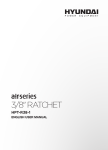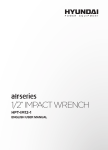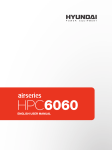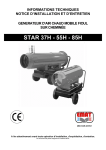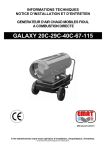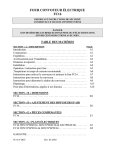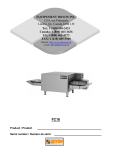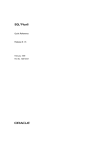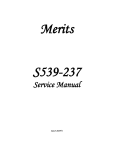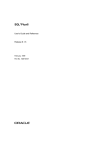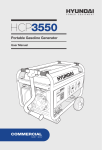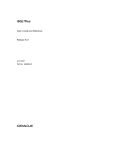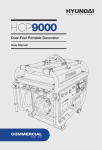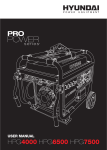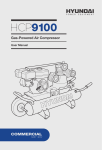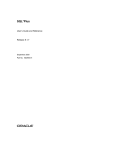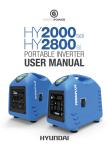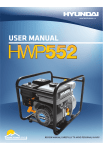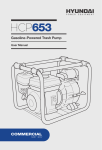Download Use and Care Manual
Transcript
PRINTSPEC: EN2050/3010-2010v1 © 2010 MIDLAND INTERNATIONAL INC. Thank you for purchasing a Hyundai Air Compressor. Please register your product in order for us to ensure your continuous satisfaction with our product. This manual covers the safety, operation, and maintenance procedures for the HPC-2050 and HPC-3010. All information in this publication is based on the latest product information available at the time of approval for printing. No part of this publication may be reproduced without written permission. If a problem should arise, please contact us by using the contact information found at the end of this manual. It is important that this manual be read and fully understood before operating the compressor. Failure to do so may cause serious injuries and/or equipment damage. CONTENT 1. 1.1 1.2 1.3 1.4 1.5 1.6 1.7 1.8 1.9 1.10 1.11 1.12 2. 3. 4. 5. 6. 7. 8. 9. 10. Safety Instructions General Operations Safety AC Safety Guidelines Maintenance Safety Air Tank Safety Attachments and Accessories Safety Risk of Explosion or Fire Risk of Bursting Risk of Electrical Shock Risk to Breathing Risk of Burn Risk of Falling Risk of Moving Parts Specifications Features Compressor Diagram Parts List Start-up/Operation Instructions Maintenance Troubleshooting Glossary Warranty 1.1 - GENERAL OPERATION SAFETY 1. Always perform a pre-operation check before using the air compressor. 2. Operators of the unit should always be wearing appropriate approved eye and hearing protection. Under some conditions, long durations of use may contribute to hearing loss. 3. Always operate the air compressor according to the instructions for safe and dependable service. 4. Always clean and properly maintain the equipment after use. 5. To avoid harm, never operate the compressor in an enclosed area. 6. Pay attention to all warning labels and be careful not to touch the marked parts of the compressor during and immediately after operation because they may cause burns. 1.2 - AC SAFETY GUIDELINES Before connecting the compressor to an electrical device or power cord: 1. Make sure that all parts are in right working order. Faulty devices or power cords can lead to an electrical shock. 2. Turn off the air compressor immediately if the device begins to operate abnormally. Then disconnect the device and investigate the problem. 1.3 - MAINTENANCE SAFETY 1. Turn off the air compressor before performing any maintenance. Otherwise, it can cause severe personal injury and/or death. 2. Allow the air compressor to cool down before performing any maintenance. 3. Only qualified, licensed, and/or certified maintenance personnel with knowledge of fuels, electricity, and machinery hazards should perform maintenance procedures. 1.4 - AIR TANK SAFETY 1. Drain the tank daily or after each use. Make sure to properly drain condensed water from the tank in order to prevent rust and/or thinning of the steel tank. 2. If the tank develops a leak, replace it immediately with a new tank or new compressor outfit. 3. Do not attempt to modify or repair the compressor tank. Never drill, weld, or make any modifications of any kind to the tank or its attachments. 4. Do not attempt to modify the pressure switch, safety valve, or any other components that control tank pressure. The tank is designed to HPC 2050 / HPC 3010 User Manual 5 withstand specific operating pressures. Never make adjustments or substitute parts to alter the factory set operating pressures. 1.5 - ATTACHMENTS AND ACCESSORIES SAFETY 1. Do not exceed the pressure rating of air tools, spray guns, air operated accessories, air tires, hoses, and other inflatables. Exceeding pressure ratings may cause them to explode or become damaged, resulting in serious injury. 2. Make sure to follow the equipment manufacturer’s recommendation and never exceed the maximum allowable pressure rating of attachments. 3. Never use the compressor to inflate small, low pressure objects, such as children’s toys. 1.6 - RISK OF EXPLOSION OR FIRE 1. Make sure the air compressor is in a well-ventilated area, free of any combustible or flammable materials, gasoline, or solvent vapours. 2. Make sure to keep the compressor at least 20 feet away when spraying flammable materials. 3. Keep all flammable materials in a secure location away from the air compressor. 4. Do not restrict any of the compressor’s ventilation openings. This may cause overheating and could cause a fire. 5. Make sure to operate the compressor in an open area at least 3 feet away from any wall or obstruction that could restrict the airflow of the compressor. 1.7 - RISK OF BURSTING 1. Make sure to drain the tank after each use. If the tank develops a leak, replace it immediately with a new tank or new compressor outfit. 2. Do not attempt to modify or repair the tank. Any drilling, welding, or other forms of modification may result in serious injury to you and/ or others. 3. Do not adjust regulator to result in output higher than marked maximum pressure of attachment. 1.8 - RISK OF ELECTRICAL SHOCK 1. Do not operate in wet environments. 2. Do not expose the compressor to rain. 3. Make sure the compressor is properly grounded. Failure to ground the unit may increase the risk of electrical shock. 6 HPC 2050 / HPC 3010 User Manual 4. All electrical work must be performed by a qualified or licensed/certified electrician. 1.9 - RISK TO BREATHING 1. Always operate the compressor in a well-ventilated area. 2. Wear appropriate safety masks to reduce the risk of inhaling any harmful vapours. 3. Do not breathe compressed air from the compressor. The compressed air is not breathable and may contain carbon monoxide, toxic vapours, and/or solid particles. 4. Sprayed materials such as paint, paint solvents, paint remover, insecticides, weed killers, etc. contain harmful vapours and poisons. 1.10 - RISK OF BURN 1. Do not touch any exposed metal components during or immediately after use of the compressor. The compressor will remain hot for several minutes after it has been shutdown. 2. Do not move the unit while the compressor is running. 1.11 - RISK OF FALLING 1. Make sure that the compressor is in a stable and secure position before operating. 1.12 - RISK OF MOVING PARTS 1. The compressor cycles automatically when the pressure switch is in the ON position. 2. Do not remove and safety guards or covers. If guards and/or covers are damaged or removed, do not operate the compressor. 3. Make sure to release pressure, turn off, and disconnect the compressor before performing any maintenance or repairs. 4. Secure any and all loose clothing, hair, or jewellery that may be caught in the moving parts or the air vents of the compressor. 5. attachments. 6. Never use the compressor to inflate small, low pressure objects, such as children’s toys. HPC 2050 / HPC 3010 User Manual 7 SECTION 2 - SPECIFICATIONS MODEL HPC-2050 HPC-3010 RUNNING HORSEPOWER 1/3 HP 1/3 HP MAX PSI 100 PSI 100 PSI SCFM @ 40 PSI 0.5 CFM 0.5 CFM SCFM @ 90 PSI 0.4 CFM 0.4 CFM 2 Gal 2.6 Gal TANK SIZE SECTION 3 FEATURES Pressure Switch This controls the power to the motor and the cut-in/cut-out pressure settings. Also serves as the Auto-On/Off positions for the unit. Safety Valve This valve allows excess tank pressure to escape into the atmosphere. It should open when tank pressure exceeds the maximum pressure rating. Check Valve This valve closes when the pump is not in operation in order to retain air pressure in the tank. Tank Pressure Gauge Indicates the reserve air pressure in the tank. Outlet Pressure Gauge Indicates the outgoing air pressure to the tool or accessory. Regulator Controls the air pressure leaving from the tank. Drain Valve Used to drain excess moisture and condensation from the tank. Air Compressor Pump Oil-free pump that compresses the air. Pressure Release Valve This valve automatically releases compressed air momentarily when the compressor reaches cut-out pressure. Universal Quick Connect Body 8 HPC 2050 / HPC 3010 User Manual Allows for easy attachment and removal of the air hose. Motor Thermal Overload Protector If the motor begins to overheat, this protector will shut off the motor. SECTION 4 - DIAGRAMS Handle Pressure switch Safety valve Tank pressure gauge Outlet pressure gauge Quick Coupler Regulator Drain valve Air tank Handle Pressure switch Safety valve Tank pressure gauge Outlet pressure gauge Quick Coupler Regulator Air tank HPC 2050 / HPC 3010 User Manual 9 SECTION 5 - PARTS LIST (HPC 2050) 10 HPC 2050 / HPC 3010 User Manual 1 M5*50 Bolt 35 Elbow 2 Cylinder head 36 Rubber hose 3 Cylinder head support 37 Pressure switch 4 Rubber gasket 38 Tank 5 Valve plate 39 Drain valve 6 Gasket 40 Dual-adapter 7 End cap 41 Φ0.5 spring 8 End cap seal 42 Seal ring 9 Spring 43 Regulator assembly 10 Seal gasket 44 Safety valve 11 Cylinder 45 Pressure gauge 12 Crankshaft 46 Milton quick coupler 13 M6*15 bolt for crank shaft 47 Rubber feet 14 Connecting rod 48 Flat washer 15 Bearing for rod 49 Nut 16 Cover plate 50 cross recessed pan head screw 17 Piston ring 51 Power cord 18 Crankcase 52 Plastic cover 19 Shaft 53 Power switch 20 Bearing for crankcase 54 Lead wire 1 21 M5*10 bolt 55 Lead wire 2 22 Flat washer 56 Terminal ring 23 Driven gear 57 Terminal ring HPC 2050 / HPC 3010 User Manual 11 12 24 Driving gear 58 Terminal ring cover 25 Motor 59 Terminal ring cover 26 M3*30 bolt 60 Wire nail 27 Spring washer 61 Self tapping screw 28 Fan 62 Self tapping screw 29 Motor cover 63 Cross recessed pan head screw 30 Φ6 jump ring 64 Tooth face washer 31 Φ8 rubber support 65 Ring terminal 32 M6 double-screw bolt 66 Power cord cover 33 M6 nut 67 Screw 34 6 flat washer HPC 2050 / HPC 3010 User Manual PARTS LIST (HPC 3010) HPC 2050 / HPC 3010 User Manual 13 14 1 M5*50 Bolt 35 Elbow 2 Cylinder head 36 Rubber hose 3 Cylinder head support 37 Pressure switch 4 Rubber gasket 38 Tank 5 Valve plate 39 Drain valve 6 Gasket 40 Dual-adapter 7 End cap 41 Φ0.5 spring 8 End cap seal 42 Seal ring 9 Spring 43 Regulator assembly 10 Seal gasket 44 Safety valve 11 Cylinder 45 Pressure gauge 12 Crankshaft 46 Milton quick coupler 13 M6*15 bolt for crank shaft 47 Rubber feet 14 Connecting rod 48 Flat washer 15 Bearing for rod 49 Nut 16 Cover plate 50 cross recessed pan head screw 17 Piston ring 51 Power cord 18 Crankcase 52 Plastic cover 19 Shaft 53 Power switch 20 Bearing for crankcase 54 Lead wire 1 21 M5*10 bolt 55 Lead wire 2 22 Flat washer 56 Terminal ring 23 Driven gear 57 Terminal ring HPC 2050 / HPC 3010 User Manual 24 Driving gear 58 Terminal ring cover 25 Motor 59 Terminal ring cover 26 M3*30 bolt 60 Wire nail 27 Spring washer 61 Self tapping screw 28 Fan 62 Self tapping screw 29 Motor cover 63 Cross recessed pan head screw 30 Φ6 jump ring 64 Tooth face washer 31 Φ8 rubber support 65 Ring terminal 32 M6 double-screw bolt 66 Power cord cover 33 M6 nut 67 Screw 34 6 flat washer SECTION 6 - START-UP & OPERATION INITIAL INSPECTION All air compressors have been inspected carefully before leaving the factory. It is possible that poor handling during transport caused some damage to the compressor. Fully inspect the compressor before use. 1. Inspect the entire unit for any concealed and/or visible damage. 2. Make sure any damaged parts are replaced and any mechanical issues are repaired by a qualified and licensed/certified mechanic. PRE-START CHECKLIST 1. Make sure that the ON/OFF switch is in the OFF position. 2. Make sure that the tank is fully drained. 3. Make sure that the tank pressure gauge reads 0 PSI. 4. Make sure that the drain valves are closed. 5. Make sure that all covers and safety guards are properly installed and in place. HPC 2050 / HPC 3010 User Manual 15 INITIAL BREAK-IN PROCEDURE The following instructions should be followed before the first time the compressor is operated in order to optimize the life of the compressor and to help prevent any damage to the unit. 1. Make sure the regulator knob is turned fully counter-clockwise. 2. Plug the power cord into a properly grounded power outlet. 3. Open the drain valve in order to allow air to escape and prevent pressure from building up inside the tank. 4. Turn the ON/OFF switch to the ON position. 5. Allow the compressor to run for approximately 15 minutes. 6. Close the drain valve, allowing pressure to build to the cut-out pressure. The compressor will shut off automatically. 7. Use the compressed air in the tank with an approved attachment or allow it to bleed out. START-UP 1. Make sure the regulator knob is turned fully counter-clockwise. 2. Plug the power cord into a properly grounded power outlet. 3. Turn the ON/OFF switch to the ON position. 4. Allow the compressor to reach the cut-out pressure. The compressor will shut off automatically. 5. Attach a hose and the desired accessory to the unit. 6. Adjust the regulator knob to the desired pressure. SHUTDOWN 1. Make sure that the ON/OFF switch is in the OFF position. 2. Unplug the power cord from the outlet. 3. Turn regulator knob counter-clockwise until the regulated pressure gauge reads 0 PSI. 4. Remove the attached hose and accessory. 5. Drain all air and water from the air tank. 6. Once the tank is fully drained, close the drain valve. 7. Store in a safe, dry, non-freezing area. STORAGE 1. Do not store the compressor in areas that are humid and/or subject to temperature fluctuations. This may result in excess moisture or water forming in the tank, which may affect the compressors cycle times. 2. Do not store in areas with excessive dust. 3. After the ON/OFF switch is in the OFF position, unplug and properly store the power cord in a protected and safe position. 16 HPC 2050 / HPC 3010 User Manual SECTION 7 - MAINTENANCE Proper maintenance is important in order to ensure safe, economical, and trouble-free operation. Improper maintenance may cause the air compressor to malfunction and can lead to serious injuries or death. Shut off the compressor before performing any maintenance. When the engine is running, make sure the area is well ventilated. The compressed air may contain harmful vapours or particles. Use authorized parts or their equivalent. The use of replacement parts which are not equivalent quality may damage the compressor. NOTE: Some of these maintenance techniques can be dangerous and must be performed by a qualified technician. In order to maintain high performance and extend the service life of the compressor, periodical inspection and adjustments should be done based on the following maintenance schedule: PROCEDURES DAILY OR BEFORE EACH USE General Inspection X Drain condensation in tank(s) X Check for unusual noise/vibration X Check for air leaks X Check safety relief valve X AFTER EACH USE Inspect air filter, replace if necessary Clean exterior of compressor HPC 2050 / HPC 3010 User Manual OTHER Approx. every 100 hours X 17 NOTICE: 1. Service more frequently when used in dusty areas. 2. Should be serviced by an authorized service dealer. 3. Must be serviced by an authorized Hyundai Service Dealer. Failure to do so will void the warranty. SECTION 8 - TROUBLESHOOTING Many troubleshooting procedures present hazards which can result in severe personal injury or death. Only trained and experienced service personnel with knowledge of fuels, electricity, and machinery hazards should perform service procedures. Review Safety Precautions. A hot compressor can cause severe burns. Always allow the compressor set to cool before performing any maintenance service. PROBLEM CAUSE • CORRECTION • • Blown fuse or circuit breaker tripped Loose electrical connections Overheated motor Compressor does not supply enough pressure to operate • • • Air leak in safety valve Restricted air filter Defective check valve • Excessive tank pressure; Safety relief valve releasing • Compressor does not start • • • • • • 18 Defective pressure switch or improper adjustment • Check for cause and replace or reset Check wiring connections Use reset button Wait for automatic reset Check valve manually – pull upward on rings. If condition persists, replace valve Clean or replace air filter Replace check valve Check for proper adjustment and if problem persists, replace pressure switch HPC 2050 / HPC 3010 User Manual Moisture in discharged compressed air • Compressor does not or is slow to come up to speed • Compressor runs excessively hot • • • • • • Condensation in air tank caused by humidity Compressor located in damp or humid area • • Defective motor or pump Defective pressure switch Use of an extension cord • High duty cycles Compressor unit cannot supply enough air Extremely dusty atmosphere • • • • • • Excessive noise/vibration during operation • • Check valve is loose or broken Defective motor or pump HPC 2050 / HPC 3010 User Manual • • Drain tank Relocate the compressor Purchase In-Line air filter system Contact Hyundai Power Customer Service Replace the pressure switch If possible, eliminate extension cord Run compressor for lighter cycles If accessory’s required CFM is higher than pressure supply, larger compressor is required Relocate the compressor Clean or replace check valve Contact Hyundai Power Customer Service 19 Excessive starting and stopping • • • • • Air leaks • • • Hose, hose connections, or attached accessory leaks Condensation in air tank, high humidity Fittings are not tight enough Defective pressure switch Rusted or damaged air tank • Fittings not tight enough Air leaks at hose or accessory Rusted or damaged tank • • • • • • • Check for leaks and replace if necessary Drain tank Tighten any loose fittings Replace defective switch Replace tank immediately. Do not attempt to repair the tank Tighten any loose fittings Check for leaks and replace if necessary Replace tank immediately. Do not attempt to repair the tank SECTION 9 - GLOSSARY CFM – Cubic Feet per Minute Cut-In Pressure – The tank’s lowest pressure point at which the motor restarts automatically to build pressure. Cut-Out Pressure – The tank’s maximum pressure point at which the motor shuts off automatically. Cycle – The series of steps that a compressor performs. Cycle Time – The amount of time for a compressor to complete one cycle. HP – Horsepower required at the compressor shaft to perform. PSI – Pounds per Square Inch; A unit of measure of pressure. Regulator – Device used to change the pressure from the compressor. SCFM – Standardized Cubic Feet per Minute; a measure of airflow 20 HPC 2050 / HPC 3010 User Manual SECTION 10 - WARRANTY Midland International Inc. 26 Huddersfield Rd. Unit #2 Etobicoke, Ontario Canada, M9W 5Z6 This product is warranted to be free of defects in materials and workmanship for one year from the original date of purchase. This limited warranty guarantees that any defective parts will be repaired or replaced, at the warrantor’s discretion, at no cost, including diagnosis and replacement parts. 1 Year Limited Warranty: The warranty coverage is continual from the initial date of purchase and does not restart at anytime under any circumstances. This limited warranty is valid only when the air compressor receives all necessary preventative maintenance, as described in the Hyundai Air Compressor User Manual. The repair or replacement of a compressor will take place within a reasonable period of time during normal business hours. All repaired and replacement parts shall be warranted for 90 days after the initial date of installation or purchase. Limitations of Remedies and Disclaimers THE FOREGOING LIMITED WARRANTY IS EXCLUSIVE OF AND IN LIEU OF ALL OTHER WARRANTIES OF MERCHANTABILITY, FITNESS FOR A PARTICULAR PURPOSE, AND OF ANY OTHER WARRANTY, WHETHER EXPRESSED OR IMPLIED. Midland International Inc. disclaims any responsibility for any indirect, incidental, or consequential loss or damage caused by any defects in material or workmanship. This limited warranty will be voided if the compressor is used for commercial purposes. All expenses incurred in maintaining and replacing parts for the compressor shall be incurred by the purchaser. This warranty coverage does not include parts affected by accident and/or collision, corrosion or rust, normal wear, use in an apHPC 2050 / HPC 3010 User Manual 21 plication for which the product was not intended, service from an unauthorized service dealer, or any other misuse, neglect, incorporation or use of unsuitable attachments and/or parts. Under this warranty, the warrantor is not obligated to bear any transportation fees of any product to/from an authorized service dealer. Unauthorized alteration, installation, or any cause other than defects in material or workmanship of the product will not be covered under this warranty. Not covered by this Limited Warranty: 1. Normal motor/pump wear 2. Damage caused by a lack of maintenance as described in the Hyundai User Manual. 3. Damage caused by accidents, improper installation or storage. 4. Damage caused by water ingestion, submersion, or external water damage. 5. Damage or non-performance caused by operation of the compressor set in a marine application. 6. Damage caused by operation with improper pressure, conditions, or modifications contrary to published specifications. 7. Items not supplied by Hyundai, such as, but not limited to, external wiring, filters, etc. 8. Repairs made during the warranty period without first obtaining a case number from Hyundai. Product Registrations Product registration is required for all product support and warranty coverage. The purchaser must also provide the original proof of purchase. The owner’s registration, found in the user manual, must be completed and mailed. You can also register online at www.hyundaipower.ca. You should keep your receipt for proof of purchase. Warranty Claim Procedure Warranty service must be performed by a Hyundai authorized service dealer. If you feel your compressor is malfunctioning due to a defect or misuse, simply contact our customer support center for technical advice, a warranty claim, or general information. Do not return your compressor to the place of purchase or repair. MIDLAND INTERNATIONAL INC. MUST BE CONTACTED TO PROVIDE A CASE NUMBER 22 HPC 2050 / HPC 3010 User Manual BEFORE ANY WARRANTY WORK CAN BEGIN. To obtain warranty service, contact our customer support center: Toll Free: 1-877-528-3772 E-mail: [email protected] Website: www.Hyundaipower.ca HPC 2050 / HPC 3010 User Manual 23























